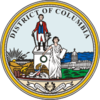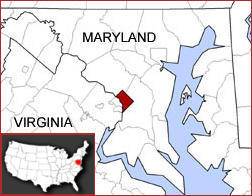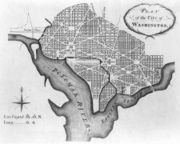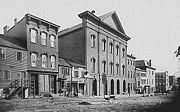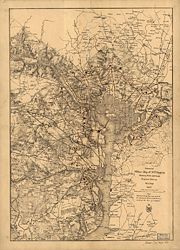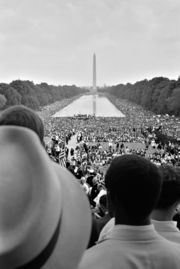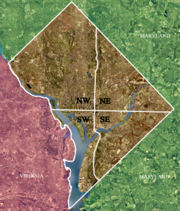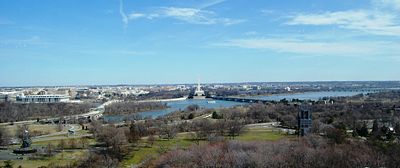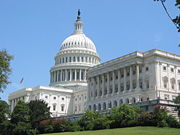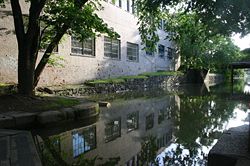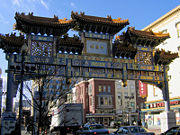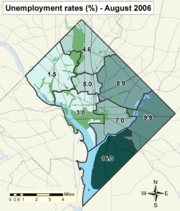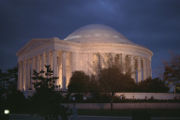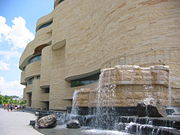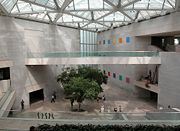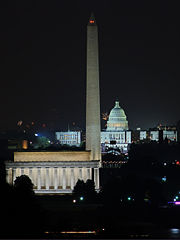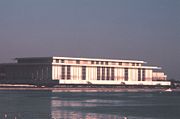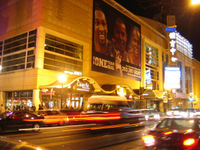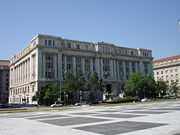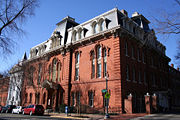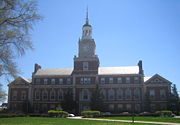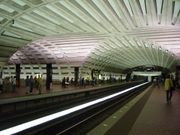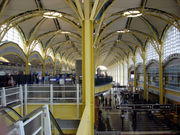Washington, D.C.
2008/9 Schools Wikipedia Selection. Related subjects: Cities; North America
| District of Columbia | |||
|
|||
| Nickname: DC, The District | |||
| Motto: Justitia Omnibus (Justice for All) | |||
| Location of Washington, D.C. in relation to the states Maryland and Virginia | |||
| Coordinates: | |||
|---|---|---|---|
| Country | United States | ||
| Federal district | District of Columbia | ||
| Government | |||
| - Mayor | Adrian Fenty ( D) | ||
| - D.C. Council | Chairperson: Vincent Gray (D) | ||
| Area | |||
| - City | 68.3 sq mi (177.0 km²) | ||
| - Land | 61.4 sq mi (159.0 km²) | ||
| - Water | 6.9 sq mi (18.0 km²) | ||
| Elevation | 0–409 ft (0–125 m) | ||
| Population (2007) | |||
| - City | 588,292 | ||
| - Density | 9,015/sq mi (3,481/km²) | ||
| - Metro | 5.30 million | ||
| Time zone | EST ( UTC-5) | ||
| - Summer ( DST) | EDT ( UTC-4) | ||
| Website: http://www.dc.gov/ | |||
Washington, D.C. (pronounced /ˈwɒʃɪŋtən diːsiː/) (commonly referred to as Washington; the District; or simply D.C.) is the capital of the United States founded on July 16, 1790. Washington (the city) covers the same area as (i.e. is coterminous with) the District of Columbia and they are considered to be the same entity. The District of Columbia is located on the banks of the Potomac River and bordered by the states of Virginia to the southwest and Maryland to the northwest, northeast, and southeast. Washington has a resident population of 588,292; however, the city's population rises to over one million people during the workweek due to commuters from the surrounding suburbs. The Washington Metropolitan Area has a population of 5.3 million, the eighth-largest in the country.
Article One of the United States Constitution provides for a federal district, distinct from the states, to serve as the permanent national capital. The centers of all three branches of the federal government of the United States are located in the District, as are many of the nation's monuments and museums. Washington, D.C. hosts 172 foreign embassies as well as the headquarters of the World Bank, the International Monetary Fund (IMF), the Organization of American States (OAS), the Inter-American Development Bank, and other national and international institutions, including trade unions and professional associations.
The United States Congress has supreme authority over Washington, D.C., which results in residents of the city having less self-governance than residents of the states. The District has a non-voting at-large Congressional delegate, but no senators. If Washington, D.C. were a state, it would rank last in area (behind Rhode Island), second to last in population (ahead of Wyoming), first in population density, 35th in gross state product, and first in percentage of African Americans, which would make Washington, D.C. a minority-majority state.
History
James Madison first brought up the need for a Federal district in The Federalist No. 43. He argued that the national capital needed to be distinct from the states in order to provide for its own maintenance and safety. An attack on the Congress at Philadelphia in June 1783 by a mob of angry soldiers emphasized the need for the government to provide for its own security. Madison and Alexander Hamilton agreed upon the location of the new capital at a dinner hosted by Thomas Jefferson. This Compromise of 1790 approved Hamilton's plan to allow the Federal government to assume war debt carried by states. In return, Madison and Jefferson were able to ensure that the new national capital would be located in the South.
On July 16, 1790, the Residence Act established the District as the new permanent capital to be located on the Potomac River. George Washington chose the exact site for the city and it was named in his honour on September 9, 1791. The federal district was named the District of Columbia because Columbia was a poetic name for the United States used at the time.
The initial plan for the "Federal District" was a diamond, measuring 10 miles (16 km) on each side, totaling 100 square miles (259 km²). As originally platted, both Maryland and Virginia ceded portions of their territory to form the District, which Congress organized into two separate counties; the County of Washington was on the north bank of the Potomac and Alexandria County was on the south bank. In 1791–92, Andrew Ellicott and Benjamin Banneker surveyed the border of the District with both Maryland and Virginia, placing boundary stones at every mile point; many of which are still standing.
The plans for the City of Washington were largely the work of Pierre Charles L’Enfant, a French-born architect, engineer, and city planner who first arrived in the American colonies as a military engineer with Major General Lafayette. Although plans for the new City of Washington placed it in the geographic and geometric centre of the federal territory, there were also a number of other communities located in the District of Columbia including Georgetown, "Tennally's Town" (i.e., Tenleytown), and a village commonly known today as Anacostia. In time, all of these communities would be annexed by the City of Washington.
On August 24, 1814, British forces burned the capital during the most notable raid of the War of 1812, in retaliation for the sacking and burning of York (modern-day Toronto). Initially, the British had approached the city hoping to secure a truce but were fired upon, which ultimately led to the sacking of government buildings. The Capitol, Treasury and White House were burned and gutted. Most government buildings were quickly repaired but the Capitol, which was still largely under construction, would not be completed until 1868.
In the 1830s, the District's southern county of Alexandria went into economic decline due in part to heavy competition by the port of Georgetown, which was further inland and on the C&O Canal. At the time, Alexandria was a major market in the American slave trade, but rumors circulated that abolitionists were attempting to end slavery in the nation's capital. In part to avoid an end to the lucrative slave trade, a referendum to ask for the retrocession of Alexandria back to the Commonwealth of Virginia succeeded in 1846 and Congress complied on July 9 of that year. Six years later, the Compromise of 1850 outlawed the slave trade in the District, though not slavery.
Washington remained a small city until the outbreak of the American Civil War in 1861. The significant expansion of the federal government as a result of the war led to notable growth in the city's population, as did a large influx of freed slaves. By 1870, the District's population had grown to nearly 132,000. Despite the city's growth, Washington still had dirt roads and lacked basic sanitation; the situation was so bad that some members of Congress proposed moving the capital elsewhere. In 1871, Congress passed the District of Columbia Organic Act, which created a single municipal government for the entire District; effectively annexing Georgetown and other areas. In the same Act, Congress also appointed a Board of Public Works charged with modernizing the city. In 1873, President Grant appointed the board's most influential member, Alexander Shepherd, to the new post of governor. That year, Shepherd spent $20 million on public works ($342 million in 2007), which modernized Washington but also bankrupted the city. In 1874, Congress abolished Shepherd's office in favour of direct rule that would continue for a century.
The District's population remained relatively stable until the Great Depression in the 1930s when President Franklin D. Roosevelt's New Deal legislation expanded the bureaucracy in Washington. World War II further increased government expenditures and the number of federal employees in the capital; by 1950, the District's population reached a peak of 802,178 residents.
After the assassination of civil rights leader Martin Luther King, Jr., in Memphis, Tennessee on April 4, 1968, riots broke out, primarily in the U Street, 14th Street, and 7th Street corridors in Northwest Washington. The violence raged for four days and many stores and other buildings were burned; most remained in ruins and have only recently been rebuilt. President Lyndon B. Johnson ordered over 13,000 federal and national guard troops to occupy the city in order to quell the violence — the largest occupation of an American city since the Civil War.
In 1973, Congress enacted the District of Columbia Self-Rule and Governmental Reorganization Act, providing for an elected mayor and city council for the District. With this change, Walter Washington became the first elected and first African American mayor of Washington, D.C. in 1975. In 1979, Marion Barry was elected mayor and then reelected twice more, serving three successive four-year terms. After his arrest for drug use in a Federal Bureau of Investigation sting operation on January 18, 1990, and sentence to a six-month jail term, Barry did not seek re-election. His successor, Sharon Pratt Kelly, became the first black woman to lead a U.S. city of Washington's size. Barry ran again in 1994, defeating Kelly in the Democratic primary and winning the general election for mayor. During his fourth term, the city became nearly insolvent and Congress forced the city to give up some home rule to an appointed financial control board.
On September 11, 2001, terrorists hijacked American Airlines Flight 77 and at 9:37AM deliberately crashed the Boeing 757 into the Pentagon, just across the Potomac River in Arlington, Virginia. The impact caused a partial collapse of one side of the building. September 11 planners Khalid Sheikh Mohammed and Ramzi Binalshibh claim in taped interviews that the United States Capitol was another intended target for the hijacked plane. Al-Qaeda leader Abu Zubaydah told American interrogators that the White House was the target of another flight that same day, United Airlines Flight 93, which crashed near Shanksville, Pennsylvania.
Geography
Washington, D.C. is located at (the coordinates of the Zero Milestone, on the Ellipse). According to the United States Census Bureau, the city has a total area of 68.3 square miles (177.0 km²). 61.4 square miles (159.0 km²) of it is land and 6.9 square miles (18.0 km²) of it (10.16%) is water.
Washington is surrounded by the states of Maryland (on its southeast, northeast and northwest sides) and Virginia (on its western side). The District interrupts those states' common border, the Potomac River, both upstream and downstream from the District. The Potomac River, as it passes Washington, is almost entirely within the District of Columbia. Washington has three major natural flowing streams: the Potomac River, the Anacostia River and Rock Creek. The Anacostia River and Rock Creek are tributaries of the Potomac River. There are three man-made reservoirs located in the city: Dalecarlia Reservoir, which crosses over the northwest border of the District into Maryland; McMillan Reservoir near Howard University; and Georgetown Reservoir.
The highest natural point in the District of Columbia is 409 feet (125 m) above sea level in Tenleytown. The lowest point is sea level, which occurs along all of the Anacostia shore and all of the Potomac shore except the uppermost portion (the Little Falls area, upstream of Chain Bridge). The geographic centre of the District of Columbia is located near 4th Street NW, L Street NW, and New York Avenue NW.
Cityscape
Washington, D.C. is a planned city. In 1791 Pierre L'Enfant drew up a basic plan for the city modeled in the Baroque style, which incorporated broad avenues radiating out from traffic circles, providing for maximum open space and landscaping. However, at the start of the 20th century, L'Enfant's vision of a capital with open parks and grand national monuments was marred by slums and randomly-placed buildings, including a railroad station on the National Mall. In 1900, Congress formed a joint committee, headed by Senator James McMillan, charged with beautifying Washington's ceremonial core. What became known as the McMillan Plan was finalized in 1901 and included the re-landscaping of the Capitol grounds and Mall, constructing new Federal buildings and monuments, clearing slums, and establishing a new citywide park system. Architects recruited by the committee kept the city's original layout and their work is thought to be the grand completion of L'Enfant's intended design.
After the construction of the twelve-story Cairo Apartment Building in 1899, Congress passed the Heights of Buildings Act, which declared that no building could be taller than the Capitol. The Act was amended in 1910 to restrict building height to the width of the adjacent street, plus 20 feet (6 meters). Today the skyline remains low and sprawling, keeping with Thomas Jefferson's wishes to make Washington an "American Paris" with "low and convenient" buildings on "light and airy" streets. As a result, the Washington Monument remains the District's tallest structure. However, Washington's height restriction has been assailed as a primary reason why the city has inflated rents, limited affordable housing, and traffic problems as a result of urban sprawl. To escape the District's height restriction, architects wishing to construct higher buildings close to downtown often do so in Rosslyn, Virginia, directly across the Potomac River from Georgetown.
The District is divided into four quadrants of unequal area: Northwest (NW); Northeast (NE); Southeast (SE); and Southwest (SW). The axes bounding the quadrants radiate from the U.S. Capitol building. In most of the city, the streets are set out in a grid pattern with east-west streets named with letters (e.g. C Street SW, L Street NE, etc.) and north-south streets with numbers (e.g. 4th Street NW, 18th Street NW, etc.). The avenues radiating from the traffic circles are primarily named after the states; all 50 states are included in the street nomenclature. As the city grew, the street names were simply extended, where possible. It is important to note that all road names include the quadrant abbreviation to indicate their location. For example, R Street NW and R Street SE are two entirely different streets. Some Washington streets are particularly noteworthy such as Pennsylvania Avenue, which connects the White House with the Capitol, and K Street, which houses the offices of many think tanks and lobbying groups. Washington hosts 172 foreign embassies; 57 of which are located on a section of Massachusetts Avenue informally known as Embassy Row.
Architecture
The architecture of Washington, D.C. varies greatly; in fact, it can be said that there is no single architectural theme in the city apart from building height. Even so, six of the top ten buildings in the American Institute of Architects' 2007 ranking of " America's Favorite Architecture" are located in the District of Columbia, including: the White House; the Washington National Cathedral; the Thomas Jefferson Memorial; the United States Capitol; the Lincoln Memorial; and the Vietnam Veterans Memorial. The neoclassical, Georgian, gothic, and modern architectural styles are all reflected among those six buildings and many other prominent government buildings in Washington. Notable exceptions to this include buildings constructed in the French Second Empire style such as the Old Executive Office Building and Library of Congress.
Outside of downtown Washington, architectural styles are even more varied. In parts of the "Old City" (the area part of L'Enfant's original plans), historic buildings are designed primarily in the Queen Anne, Châteauesque, Richardsonian Romanesque, Georgian revival, and Beaux-Arts styles, as well as other varieties of Victorian architecture. Rowhouses from the 19th century are especially prominent in areas of the Old City and typically follow Federalist and late Victorian designs. Outside of the city's main grid system, housing designs are less regular and vary not only between neighborhoods but often between city blocks as well. Georgetown has the most prominent remaining style; most homes reflect late Victorian architecture from the 1870s. Georgetown University, however, is more distinct with a mix of Romanesque and Gothic Revival architecture.
Nature
The U.S. National Park Service manages most of the natural habitat in Washington, D.C., including Rock Creek Park, the Chesapeake and Ohio Canal National Historical Park, the National Mall, Theodore Roosevelt Island, and Anacostia Park. The U.S. Department of Agriculture operates the U.S. National Arboretum while various other federal agencies, both military and civilian, have minor holdings of wild land within the District. The Great Falls of the Potomac River are located upstream (i.e. northwest) of Washington. George Washington once surveyed this area for a "Pawtomack" Canal that would allow barge traffic to bypass the falls. The Potomac Gorge, also known as Mather Gorge, cuts into hard metamorphic bedrock and extends from Great Falls downstream to Georgetown, Rosslyn, Virginia, and Theodore Roosevelt Island, all located at the boundary between the Piedmont and the Coastal Plain.
The Potomac River was once called a "national disgrace" by President Lyndon Johnson, who lobbied for the passage of the Clean Water Restoration Act in 1966. The river is now home to a vibrant warm-water fishery and naturally reproducing Bald Eagles have returned to its banks. Despite its intensely urbanized landscape, the District of Columbia is a centre for research on urban wildlife management, invasive species management, urban stream restoration, and the aquatic ecology of urban streams. The National Park Service's Centre For Urban Ecology is a regional source of expertise and applied science for the region.
Climate
Washington has a humid subtropical climate ( Köppen climate classification: Cfa). Its climate is typical of Mid-Atlantic U.S. areas removed from bodies of water, with four distinct seasons. Spring and fall are mild with low humidity and high temperatures in April and October averaging in the high 60s to low 70s in ° F (about 20 ° C). Winter brings sustained cool temperatures and occasional snowfall. Average highs tend to be in the low 40s (6 to 8 °C) and lows in the mid 20s (-5 to -2 °C) from mid-December to mid-February. Additionally, Arctic air can lower nighttime lows into the teens, even in the city. Summer tends to be hot and humid with daily high temperatures in July and August averaging in the high 80s to low 90s (about 30 to 33 °C). The combination of heat and humidity in the summer brings very frequent thunderstorms, some of which occasionally produce tornadoes in the area.
While hurricanes (or their remnants) occasionally track through the area in late summer and early fall, they have often weakened by the time they reach Washington partly due to the city's inland location. Flooding of the Potomac River, however, caused by a combination of high tide, storm surge, and runoff, has been known to cause extensive property damage in Georgetown as well as in nearby Old Town Alexandria, Virginia.
The average annual rainfall is 39.3 inches (998 mm) and average annual snowfall is 16.6 inches (422 mm). Some outlying suburbs to the north and west receive upwards of six more inches of snowfall each year. The average annual temperature is 57.5 °F (14.1 °C). The highest recorded temperature was 106 °F (41 °C) on July 20, 1930 and August 6, 1918, while the lowest recorded temperature was -15 °F (-26 °C) on February 11, 1899, during the Great Blizzard of 1899. The city averages 36.7 days hotter than 90 °F (32 °C), and only 64.4 nights below freezing.
| Weather averages for Washington, D.C. | |||||||||||||
|---|---|---|---|---|---|---|---|---|---|---|---|---|---|
| Month | Jan | Feb | Mar | Apr | May | Jun | Jul | Aug | Sep | Oct | Nov | Dec | Year |
| Record high °F (°C) | 79 (26) | 82 (28) | 89 (32) | 95 (35) | 99 (37) | 101 (38) | 104 (40) | 103 (39) | 101 (38) | 94 (34) | 86 (30) | 75 (24) | 104 (40) |
| Average high °F (°C) | 43 (6) | 46 (8) | 55 (13) | 67 (19) | 76 (24) | 84 (29) | 88 (31) | 86 (30) | 80 (27) | 69 (21) | 58 (14) | 47 (8) | 67 (19) |
| Average low °F (°C) | 28 (-2) | 30 (-1) | 37 (3) | 46 (8) | 56 (13) | 65 (18) | 70 (21) | 69 (21) | 62 (17) | 50 (10) | 40 (4) | 32 (0) | 49 (9) |
| Record low °F (°C) | -5 (-21) | 4 (-16) | 14 (-10) | 24 (-4) | 34 (1) | 47 (8) | 54 (12) | 49 (9) | 39 (4) | 29 (-2) | 16 (-9) | 3 (-16) | -5 (-21) |
| Precipitation inches (mm) | 2.8 (71.1) | 2.6 (66) | 3.4 (86.4) | 2.8 (71.1) | 3.9 (99.1) | 3.3 (83.8) | 4.0 (101.6) | 4.1 (104.1) | 3.3 (83.8) | 3.0 (76.2) | 3.0 (76.2) | 3.1 (78.7) | 39.3 (998.2) |
| Source: Weatherbase Jun 2008 | |||||||||||||
Demographics
| Historical populations | |||
|---|---|---|---|
| Census | Pop. | %± | |
| 1800 | 8,144 |
|
|
| 1810 | 15,471 | 90% | |
| 1820 | 23,336 | 50.8% | |
| 1830 | 30,261 | 29.7% | |
| 1840 | 33,745 | 11.5% | |
| 1850 | 51,687 | 53.2% | |
| 1860 | 75,080 | 45.3% | |
| 1870 | 131,700 | 75.4% | |
| 1880 | 177,624 | 34.9% | |
| 1890 | 230,392 | 29.7% | |
| 1900 | 278,718 | 21% | |
| 1910 | 331,069 | 18.8% | |
| 1920 | 437,571 | 32.2% | |
| 1930 | 486,869 | 11.3% | |
| 1940 | 663,091 | 36.2% | |
| 1950 | 802,178 | 21% | |
| 1960 | 763,956 | −4.8% | |
| 1970 | 756,510 | −1% | |
| 1980 | 638,333 | −15.6% | |
| 1990 | 606,900 | −4.9% | |
| 2000 | 572,059 | −5.7% | |
| Est. 2007 | 588,292 | 2.8% | |
The current 2007 U.S. Census Bureau data estimates the District's population at 588,292 residents, continuing a trend of population growth in the city since the 2000 Census. The trend reverses what had been a 50-year decline in the District's population. During the workweek, however, the number of commuters from the suburbs into the city swells the District's population an estimated 71.8% to a daytime population of over one million people. The Washington Metropolitan Area, which includes the surrounding counties in Maryland and Virginia, is the eighth-largest in the United States with more than five million residents. When combined with Baltimore and its suburbs, the Baltimore-Washington Metropolitan Area has a population exceeding eight million residents, the fourth-largest in the country.
In 2006, the population distribution was 55.5% African American, 34.5% Caucasian, 8.2% Hispanic (of any race), 5.1% other (including Native Americans, Alaskans, Hawaiians, and Pacific Islanders), 3.4% Asian, and 1.5% mixed (two or more races). Even though they comprise the city's largest ethnic group, Washington has a steadily declining African American population, due to many middle-class and professional African Americans leaving the city for suburbs. At the same time, the city's white population has steadily increased, in part due to effects of gentrification in many of Washington's traditionally black neighborhoods. This is evident in a 4.6% decrease in the African American population, and a corresponding 3.7% increase in the Caucasian population since 2000. The 2006 American Community Survey found that only 40% of current D.C. residents were born in the District, 16% below the national average.
Also using data from the 2000 census, research shows that there are an estimated 33,000 gay, lesbian, or bisexual adults in the District of Columbia, about 6% of the city's population; twice the national average of 2.9%. Despite the city's sizable LGBT population and liberal political climate, same-sex marriage is not legal in the District; due in part to opposition in Congress. However, Washington's domestic partnership law does provide same-sex couples legal recognition similar to civil unions offered in other jurisdictions.
A 2007 report found that about one-third of Washington residents are functionally illiterate, compared to a national rate of about one in five. This is attributed in part to Hispanic, Ethiopian, and Eritrean immigrants that make up 12.7 percent of the District's population but are not proficient in English. However, while one-third are functionally illiterate, 45 percent of D.C. residents have at least a four-year college degree, the fourth-highest rate in the nation, which further illustrates the social divide present in the city. A 2000 study shows that 83.42% of Washington, D.C. residents age 5 and older speak only English at home and 9.18% speak Spanish. French is the third-most-spoken language at 1.67%. Nearly three out of four District residents identify themselves as Christian; 27% of residents are Catholic, 19% are Baptist, and 26% are members of other Protestant denominations. Followers of Buddhism make up 4% of the population, Islam 2%, and Judaism 1%. 13% of residents do not practice a religion.
Crime
During the violent crime wave of the early 1990s, Washington, D.C. was known as the "murder capital" of the United States and often rivaled New Orleans in the number of homicides. The number of murders peaked in 1991 at 482, but the level of violence declined drastically in the 1990s. By 2006, the annual murder count in the city had declined to 169. Other forms of property crime, including thefts and robberies, also declined by similar percentages. Despite the declining trends, the FBI's 2006 Uniform Crime Report still ranks overall crime in Washington as the seventh-highest in the nation among cities with populations over 250,000.
Like most large cities, crime is highest in areas associated with illegal drugs and gangs. The more affluent neighborhoods of Northwest Washington experience low levels of crime, but the incidence of crime increases as one goes further east (see map at right). Once plagued with violent crime, many D.C. neighborhoods such as Columbia Heights and Logan Circle are becoming safe and vibrant areas due to the effects of gentrification. As a result, crime in the District is being displaced even further east and across the border into Prince George's County, Maryland.
On June 26, 2008, the Supreme Court of the United States held that the District of Columbia's 1976 handgun ban violates the Second Amendment right to gun ownership. However, the ruling does not prohibit all forms of gun control; laws requiring firearm registration remain in place as does the city's assault weapon ban. The case is District of Columbia v. Heller.
Economy
Washington, D.C. has a growing, diversified economy with an increasing percentage of professional and business service jobs. The gross state product of the District in 2007 was $93.8 billion, ranking at number 35 when compared with the fifty states. As of March 2008, the federal government accounted for about 27 percent of the jobs in Washington, D.C. Many other businesses such as law firms, independent contractors (both defense and civilian), nonprofit organizations, lobbying firms, national associations of labor and professional groups, catering, and administrative services companies are directly or indirectly sustained by the federal government. Washington is thought to be relatively immune to downturns in the national economy because the federal government, and those who work with it, continue operations even during economic recessions.
The District serves as an economic anchor to the metropolitan area. Many of the jobs in D.C. are filled by commuters from the Maryland and Virginia suburbs, thereby contributing to the economic growth of both states. Further, the presence of many major government agencies outside of the District, including the Department of Defense, National Institutes of Health, and the Food and Drug Administration, has led to additional economic development in the D.C. area. As of March 2008, the Washington Metropolitan Area had an unemployment rate of 3.4 percent; the lowest rate among the 40 largest metro areas in the nation. It is also significantly lower than the national average unemployment rate of 5.2 percent.
Washington has growing industry unrelated to government, especially in the areas of education, finance and scientific research. The George Washington University, Georgetown University, Washington Hospital Centre, Howard University, and Fannie Mae are the top five non-government-related employers in the city. There are five Fortune 1000 companies based in Washington, of which two are also Fortune 500 companies. The city has become a leader in global real estate investment, behind London, New York City, and Paris. In 2006, Expansion Magazine ranked D.C. among the top ten areas in the nation favorable to business expansion. Washington has the third-largest downtown in the United States in terms of commercial office space, directly behind New York City and Chicago.
Gentrification efforts are taking hold in Washington, D.C., reviving once-decaying neighborhoods into thriving urban centers. Most notable are the changes made in the U Street Corridor, Logan Circle, the 14th Street Corridor, Shaw, and Columbia Heights. A new shopping mall opened in Columbia Heights in March 2008 represents the first new major retail centre in the District in 40 years. Gentrification, however, while helping revitalize the city's economy, is not directly helping poor communities as much as it is replacing them with new higher-income residents. Further, the benefits of economic growth are not evenly distributed throughout the city. For example, the District's unemployment rate fluctuates greatly within the city from 1.5 percent in affluent Ward 4 to 16.3 percent in Ward 8 (see graphic). According to the U.S. Census Bureau in 2005, when compared with the states, the District has the highest personal income per capita in the country but also has the highest poverty rate, which further serves to highlight the economic disparities still present in the city.
Culture
Historic sites and museums
Washington has numerous national landmarks. The National Mall is a large, open park area in the center of the city featuring many monuments to American leaders. Located prominently in the centre of the Mall is the Washington Monument. Other notable points of interest on the Mall include the Lincoln Memorial, the National World War II Memorial at the east end of the reflecting pool, the Korean War Veterans Memorial, the Vietnam Veterans Memorial, and the Albert Einstein Memorial. Also located on the mall, the National Archives houses thousands of documents important to American history including the Declaration of Independence, the United States Constitution, and the Bill of Rights.
Located directly south of the mall, the Tidal Basin features rows of Japanese cherry blossom trees that were presented as gifts from the nation of Japan to the city as a symbol of friendship in 1912 and again in 1965 after World War II. Each year the Tidal Basin hosts the National Cherry Blossom Festival, which draws thousands tourists to Washington when the trees are in peak bloom. The Franklin Delano Roosevelt Memorial, Jefferson Memorial, and the District of Columbia War Memorial are located around the Tidal Basin.
The Smithsonian Institution is an educational foundation chartered by Congress in 1846 that maintains most of the nation's official museums and galleries in Washington, D.C. The U.S. government partially funds the Smithsonian, thus making its collections open to the public free of charge. The most visited of the Smithsonian museums is the National Museum of Natural History located on the National Mall. Other Smithsonian Institution museums and galleries located on the mall are: the National Air and Space Museum; the National Museum of African Art; the National Museum of American History; the National Museum of the American Indian; the Sackler and Freer galleries, which both focus on Asian art and culture; the Hirshhorn Museum and Sculpture Garden; the Arts and Industries Building; and the Smithsonian Institution Building (also known as "The Castle"), which serves as the Smithsonian Institution's headquarters.
The Smithsonian American Art Museum (formerly known as the National Museum of American Art) and the National Portrait Gallery are located in the same building, the Donald W. Reynolds Centre, near Washington's Chinatown. The Renwick Gallery is officially part of the Smithsonian American Art Museum but is located in a separate building near the White House. The Reynolds Centre was known as the Old Patent Office Building until 2006, and many still refer to the building using its former name. Other Smithsonian museums and galleries include: the Anacostia Community Museum in Southeast Washington; the National Postal Museum near Union Station; and the National Zoo in Woodley Park.
The National Gallery of Art is located on the National Mall near the Capitol, but is not a part of the Smithsonian Institution; it is instead wholly owned by the U.S. government. As a government institution, admission to the gallery is free. The gallery's west wing features the nation's collection of American and European art through the 19th century. The east wing, designed by architect I.M. Pei, features works of modern art. Given the similarities in their names and collections, the Smithsonian American Art Museum and the National Portrait Gallery are often confused with the National Gallery of Art when they are in fact entirely separate institutions. The National Building Museum, located near Judiciary Square, was chartered by Congress and hosts temporary and traveling exhibits.
There are many private art museums in the District of Columbia, which house major collections and exhibits open to the public such as: the National Museum of Women in the Arts; the Corcoran Gallery of Art, the largest private museum in Washington; and The Phillips Collection in Dupont Circle, the first museum of modern art in the United States. However, as they are not chartered or funded directly by the U.S. government, there is often a fee for admission to these galleries. Other private museums in Washington include the Newseum, the International Spy Museum, the National Geographic Society museum, and the Marian Koshland Science Museum. The United States Holocaust Memorial Museum located near the National Mall maintains exhibits, documentation, and artifacts related to The Holocaust.
Other points of interest in the District include: the United States Capitol; the White House; the Library of Congress; the Supreme Court; the Washington National Cathedral in upper Northwest; the United States Navy Memorial in Penn Quarter; the Basilica of the National Shrine of the Immaculate Conception; the National Arboretum; the Folger Shakespeare Library; Ford's Theatre; the Frederick Douglass National Historic Site; the African American Civil War Memorial; Eastern Market; the Old Stone House, the oldest standing building in the District; the Mount St. Sepulchre Franciscan Monastery; and the Victims of Communism Memorial.
Performing arts and music
Washington, D.C. is a national centre for the arts. The John F. Kennedy Centre for the Performing Arts is home to the National Symphony Orchestra, the Washington National Opera, and the Washington Ballet. The Kennedy Center Honours are awarded each year to those in the performing arts who have contributed greatly to the cultural life of the United States. The President and First Lady typically attend the Honours ceremony, as the First Lady is the honorary chair of the Kennedy Centre Board of Trustees.
Arena Stage, one of the nation's first non-profit regional theaters, produces an eight-show season that features classic works and new American plays. The Shakespeare Theatre Company is a non-profit theatre founded in 1985, which critics regard as "one of the world's three great Shakespearean theatres" for its reinterpretations and production of classical plays.
Some of Washington's neighborhoods are renowned for the performing arts. The U Street Corridor in Northwest Washington, known as "Washington's Black Broadway", is home to institutions like Bohemian Caverns and the Lincoln Theatre which hosted music legends such as Washington-native Duke Ellington, John Coltrane, and Miles Davis. The U Street area has dozens of clubs and restaurants, which feature near-nightly jazz performances. Other jazz venues feature modern blues such as Madam's Organ in Adams Morgan and Blues Alley in Georgetown.
D.C. has its own native music genre called go-go; a post-funk, percussion-driven flavor of R&B that blends live sets with relentless dance rhythms, so called because they "go and go and go". The most accomplished practitioner was D.C. band leader Chuck Brown, who brought go-go to the brink of national recognition with his 1979 LP Bustin' Loose.
Washington is also an important centre for indie culture and music in the United States. The label Dischord Records, formed by Ian MacKaye, was one of the most crucial independent labels in the genesis of 1980s punk and eventually indie rock in the 1990s. Washington's indie label history includes TeenBeat, Dischord Records, Simple Machines, and ESL Music among others. Modern alternative and indie music venues like The Black Cat and the 9:30 Club near U Street bring popular acts to smaller more-intimate venues.
Sports
Washington, D.C. is home to five major professional mens' teams. The Washington Wizards ( NBA) and the Washington Capitals ( NHL) both play at the Verizon Centre (right) in Chinatown. Nationals Park, which opened in Southeast D.C. in 2008, is home to the Washington Nationals ( MLB). The D.C. United ( MLS) play at RFK Stadium. The Washington Redskins ( NFL) play at nearby FedExField in Landover, Maryland.
The Washington area is also home to a number of women's professional sports teams. The Washington Mystics ( WNBA) play at the Verizon Centre and the Washington Glory ( National Pro Fastpitch Softball) play at Westfield H.S. Sports Complex in Fairfax County, Virginia. The Washington Freedom are set to be revived in 2009 within the Women's Professional Soccer league, the successor to the WUSA. Other professional and semi-professional teams based in Washington include: the Washington Bayhawks ( Major League Lacrosse), who play at George Mason Stadium; the Washington D.C. Slayers ( American National Rugby League); the Potomac Mavericks ( PIHA); the Baltimore Washington Eagles (USAFL); the D.C. Divas ( NWFA); the D.C. Explosion (Minor League Football); and the Washington RFC ( Rugby Super League).
Washington is one of only 13 cities in the United States with a team from all four major mens' sports: football, basketball, baseball, and hockey. When soccer is included, Washington is one of only 8 cities to have all five professional mens' sports. D.C. teams have won a combined 11 professional league championships: the D.C. United has won 4 (the most in MLS history); the Washington Redskins have won 3; the Washington Bayhawks have won 2; and the Washington Wizards and the Washington Glory have each won a single championship. The William H.G. FitzGerald Tennis Centre in Rock Creek Park hosts the Legg Mason Tennis Classic. The Marine Corps Marathon and the National Marathon are both held annually in Washington. The D.C. area is home to one regional sports television network, Comcast SportsNet (CSN), based in Bethesda, Maryland.
Government
Article 1, Section 8 of the United States Constitution grants the U.S. Congress ultimate authority over the District of Columbia. The 1973 Home Rule Act devolved certain Congressional powers over the District to a local government administered by an elected mayor, currently Adrian Fenty, and the thirteen-member Council of the District of Columbia. However, Congress retains the right to review and overturn laws created by the city council and intervene in local affairs. Each of the city's eight wards elects a single member of the council and five members, including the chairman, are elected at large. The council conducts its work through standing committees and special committees established as needed. There are 37 Advisory Neighbourhood Commissions (ANCs) elected by small neighbourhood districts. ANCs traditionally wield a great deal of influence and the city government routinely takes their suggestions into careful consideration.
The mayor and council adopt a budget, which Congress has the right to change. Local income, sales, and property taxes provide most of the revenue to fund city government agencies and services. Like the 50 states, D.C. receives funds for federal grants and assistance programs like Medicare. Congress also appropriates money directly to the D.C. government to help offset some of the city's costs; these funds totaled $38 million in 2007, approximately 0.5% of the District's budget. However, in addition to those funds, the Federal government operates the District's court system, which had a budget of $272 million in 2008, and federal law enforcement agencies like the U.S. Park Police help provide security in the city as well.
Historically, the city's local government has earned somewhat of a reputation for mismanagement and waste, particularly during the mayoralty of Marion Barry. A front-page story in the July 20, 1997 Washington Post reported that Washington had some of the highest-cost yet lowest-quality services in the entire region. The administration of Mayor Anthony Williams oversaw a period greater prosperity, urban renewal, and budget surpluses starting in the late 1990s that continues on today. Despite these gains, the city still faces daunting problems that affect many urban areas such as lack of decent affordable housing and public health problems. In late 2007, investigators found that employees at the D.C. Office of Tax and Revenue embezzled over $44 million in city funds by writing fraudulent tax refund checks. The scandal resulted in a black mark for the Fenty administration, which had made regaining the public trust a top priority.
Washington, D.C. observes all Federal holidays. The District also celebrates Emancipation Day on April 16, which commemorates the signing of the Compensated Emancipation Act by President Abraham Lincoln in 1862, nine months prior to the Emancipation Proclamation. The Act ended slavery in the District of Columbia and freed about 3,100 enslaved persons. On January 4, 2005, Mayor Anthony Williams signed legislation making Emancipation Day an official holiday in the District.
Federal representation and taxation
Citizens of the District of Columbia have no voting representation in Congress. They are represented in the House of Representatives by a non-voting delegate, Eleanor Holmes Norton (D- D.C. At-Large), who may sit on committees, participate in debate, and introduce legislation, but cannot vote on the House floor. D.C. has no representation at all in the Senate. Unlike U.S. territories such as Puerto Rico or Guam, which also have non-voting delegates, citizens of the District of Columbia are subject to all U.S. federal laws and taxes. In the financial year 2005, D.C. residents and businesses paid $18.1 billion in federal taxes; higher than the federal taxes collected from 20 states. The District also pays the most federal taxes per capita.
A 2005 poll found that 78 percent of Americans did not know that residents of the District of Columbia have less representation in Congress than residents of the 50 states. Efforts to raise awareness about the issue have included campaigns by grassroots organizations as well as featuring the city's unofficial motto, " Taxation Without Representation", on D.C. vehicle license plates. In a show of support for the city, President Bill Clinton used the "Taxation Without Representation" plates on the presidential limousine; however, President George W. Bush had the tags replaced to those without the motto shortly upon taking office.
There is nationwide approval of D.C. voting rights; various polls indicate that 61 to 82 percent of Americans believe that D.C. should have voting representation in Congress. Despite public support, attempts to grant the District voting representation, including the D.C. statehood movement and the proposed District of Columbia Voting Rights Amendment, have been unsuccessful. Opponents of D.C. voting rights propose that the Founding Fathers never intended for District residents to have a vote in Congress since the Constitution makes clear that representation must come from the states. Those opposed to making D.C. a state claim that such a move would destroy the notion of a separate national capital and that statehood would unfairly grant Senate representation to a single city. The Twenty-third Amendment to the United States Constitution allows residents of Washington, D.C. to participate in presidential elections; the District is afforded three electoral votes in the selection of the President.
Education and healthcare
District of Columbia Public Schools (DCPS) operates the city's public school system, which consists of 167 schools and learning centers. In the 2007-2008 school year, 49,076 students were enrolled in the public school system. Enrollment in DCPS has been steadily decreasing and by next year the city expects total enrollment to fall to 47,700. DCPS has one of the highest-cost yet lowest-performing school systems in the country both in terms of infrastructure and student achievement. DCPS had only one school in the U.S. News and World Report's 2008 ranking of the nation's top 100 high schools. By comparison, suburban Washington public school systems had a total of 14 schools on the list. The University of the District of Columbia (UDC) provides public postsecondary education.
Under a massive restructuring of the city's school system in 2007, the D.C. Council granted the mayor's office near-total authority over D.C. public schools. Mayor Fenty's new superintendent of DCPS, Chancellor Michelle Rhee, has made sweeping changes to the school system by cutting administration staff, firing principals, ending teacher seniority, and even closing schools altogether. Due to the problems with the D.C. public school system, enrollment in public charter schools has increased 13 percent each year since 2001. As of fall 2007, D.C. charter schools had a total enrollment of 21,859 students. The District of Columbia Public Charter School Board monitors the 56 public charter schools in the city. The District also has some of the nation's most renowned private high schools. Many important political figures and their children have attended St. Albans and Sidwell Friends, including Chelsea Clinton who attended Sidwell during her father's presidency.
Washington is home to many notable universities including The George Washington University (GW), Georgetown University (GU), American University (AU), The Catholic University of America (CUA), Howard University, Gallaudet University, and The Johns Hopkins University School of Advanced International Studies (SAIS). The Corcoran College of Art and Design provides specialized arts instruction and other higher-education institutions offer continuing, distance and adult education.
The District is a national centre for patient care and medical research as well. There are a total of 16 medical centers and hospitals located within the District of Columbia. There are also numerous medical research centers in the Washington area, most notably the National Institutes of Health in Bethesda, Maryland. Washington Hospital Centre (WHC) is the largest hospital campus in the District and is both the largest private and the largest non-profit hospital in the Washington Metropolitan Area. Immediately adjacent to the WHC is the Children's National Medical Centre. Children's is among the highest ranked pediatric hospitals in the country according to U.S. News and World Report. Many of the city's prominent universities including George Washington, Georgetown, and Howard have medical schools and associated teaching hospitals. Walter Reed Army Medical Centre is located in Northwest Washington and provides care for active-duty and retired personnel and their dependents.
Transportation
Washington, D.C. is often cited as having some of the nation's worst traffic and congestion. In 2008, Forbes magazine found that Washington commuters spend 60 hours a year in traffic, which tied Atlanta, Georgia for having the worst traffic in the country after Los Angeles. However, the Washington area has the second-highest number of commuters in the country who walk, bike, carpool, or take public transportation.
The Washington Metropolitan Area Transit Authority (WMATA) operates the city's rapid transit system, Metrorail (most often referred to as simply "the Metro"), as well as Metrobus. The subway and bus systems serve both the District of Columbia and the immediate Maryland and Virginia suburbs. Metrorail opened on March 27, 1976 and presently consists of 86 stations and 106.3 miles (171.1 km) of track. With an average 950,000 trips each weekday in 2008, Metrorail is the nation's second-busiest rapid transit system in the country, after the New York City Subway.
Due to population growth in the Washington area, WMATA expects an average one million Metrorail riders daily by 2030. The need to increase capacity has pushed up plans to add two-hundred trains to the system and reroute subway lines to alleviate congestion at the busiest stations. Further, long-delayed plans to construct two additional Metro lines have since been revived with a new push to enlarge the transit system. The surrounding jurisdictions in the Washington area have local bus systems, such as Montgomery County's Ride On, which compliment service provided by WMATA. Metrorail, Metrobus and all local public bus systems accept SmarTrip, a reloadable transit pass.
Union Station is the second-busiest train station in the United States, after Penn Station in New York, and serves as the southern terminus of Amtrak's Northeast Corridor and Acela Express service. Maryland's MARC and Virginia's VRE commuter trains and the Metrorail Red Line also provide service into Union Station. Intercity bus service is available from the Greyhound Lines terminal in Northeast D.C. Other private bus lines, such as the low-cost "Chinatown" buses, mainly provide service between Washington and New York City.
Three major airports, one in Maryland and two in Virginia, serve Washington, D.C. Ronald Reagan Washington National Airport ( IATA: DCA, ICAO: KDCA), located just across the Potomac River from downtown D.C. in Arlington County, Virginia, is the only Washington-area airport that has its own Metrorail station. Given its proximity to the city Reagan National has noise restrictions and extra security precautions as required by the Air Defense Identification Zone (ADIZ). Additionally, Reagan National does not have U.S. Customs and Border Protection and therefore can only provide international service to airports that permit United States border preclearance including: Nassau, Bahamas; Bermuda; Toronto; Ottawa; and Montréal.
Major international flights arrive and depart from Washington Dulles International Airport ( IATA: IAD, ICAO: KIAD), located 26.3 miles (42.3 km) west of the city in Fairfax and Loudoun counties in Virginia. Dulles serves as the major east coast airline hub for United Airlines. Baltimore-Washington International Thurgood Marshall Airport ( IATA: BWI, ICAO: KBWI), located 31.7 miles (51.0 km) northeast of the city in Anne Arundel County, Maryland serves as a hub for both Southwest and Airtran airlines.
Sister cities
Washington, D.C. has eleven sister cities:
|


